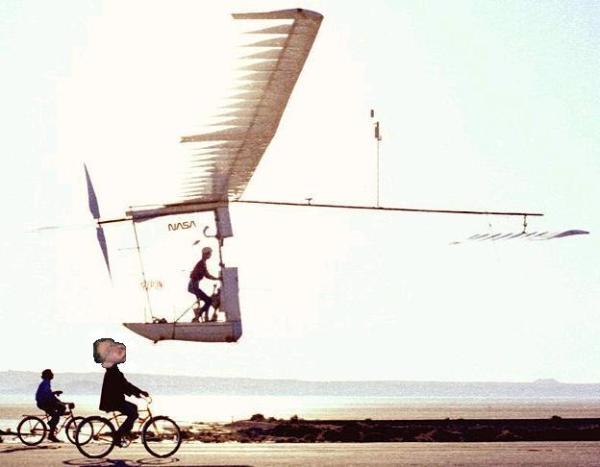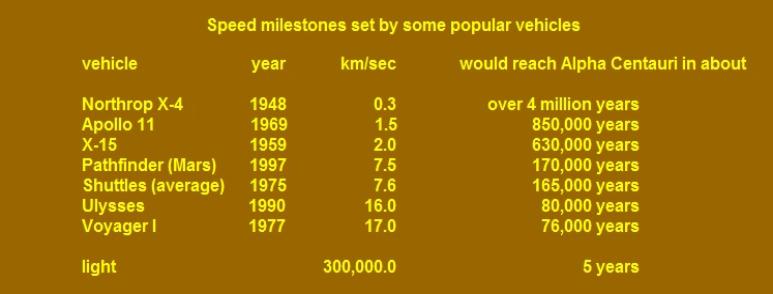| Adapted for the Internet from: Why God Doesn't Exist |
| Speed is of the essence: Why we will never travel to the nearest star |
- ________________________________________________________________________________________
- Last modified 02/27/08
- Copyright © by Nila Gaede 2008
- 4.0 Quantum technology has no pull
A final technology is the use of tethers, which are not really suited for interstellar travel, but could have served as a rapid
transit system within the Solar System. Think of a tether as a sling that has the potential to catapult probes to places like
the Moon or Mars. A trip to the red planet could take as little as 3 months. Some of this costly, energy consuming technology
may serve a scientific purpose (to send an intergenerational scouting probe to another star) or to generate power for Earth
using the laser station in the meantime. Whether politicians and businessmen will ever support such farfetched, expensive
projects remains to be seen. Under my proposed definitions, I classify laser pushed arcs and tethers under science fiction,
and in the context of interstellar travel, science fantasy. Space agencies do not take any of these schemes seriously for
interstellar travel because most dreamers working on such projects are betting that either General Relativity is fundamentally
correct and we will find a short cut through space, or that we will develop some hybrid Newtonian technology that will enable
near c travel. Otherwise, program managers say that we have no chance of seeing Alpha Centauri as anything but a tiny dot
in the night sky.
The strategic problem with interstellar travel is that we must rule out ‘pull’ technology, a mechanical method of travel that
depends on the target star towing our spacecraft in. Magnetic or gravitational attraction is out of the question either because
stars are too far away or because the inhabitants at destination would have to do something at their end to reel us in. What
the foregoing proposals have in common is that they are all ‘push’ driven, which tacitly cuts our possibilities in half. You have
to factor that the mechanics never discovered the force of pull.
In principle this doesn’t look so bad until you realize that there are only so many ways that you can push a craft and we have
probably discovered them all. Let me run them by in fast forward:
- The legs push a turtle, the fins a shark, the arm a basketball, the bat a ball, the slingshot
a pebble, the catapult a stone, the fan a fly, the air a kite, the wind a balloon, the whip the
floor, the raindrops a flower, the gun a bullet, the cannon a missile, the bulldozer a house,
the oar a boat, the paddles a steamboat, the outboard motor a speedboat, the engine a car,
the jet an airplane, the propeller a helicopter, the rocket a space-craft, planetary assist a
probe, the laser a lightsail, particle shower a magnetic sail, the solar wind a magnetic
bubble, the ion engine a rocket, ‘antiparticles’ a space-craft, fission the bomb, and fusion
the Sun.
Did I miss any? I’m sure I have, but we’ve ruled out all these methods for being too slow, too expensive, too energy-consuming,
too impractical, or all of the above. What radical new method of push are space agencies waiting to discover? For all practical
purposes, we are done with speed. We will never travel much faster than we have traveled until today.
1.0 Dreams are made of this: FTL
If we could develop technology to travel at the speed of thought -- which is akin to the Star Trek transporter solution -- our
technical troubles would be pretty much over. We think for five seconds and we're there on the sixth. The Grand Plan would
be on course and it would be a matter of time before we visit the entire Milky Way.
Short of this, the next best is the speed of light (little c). At this speed, a direct trip to Mars, a mere 78 million kilometers away,
would take about 4.5 minutes. As a reference, the 1997 Pathfinder Mission, (the one with the
little Soujourner rover) took 7 months on a 500 million kilometer hyperbolic trajectory to arrive at the red planet. Obviously,
speed is the limiting parameter.
But what can we possibly invent or discover that would take us to Mars at c? Special Relativity holds as one of its inalienable
laws that no physical object can travel at c. [1] Of course, the mathematicians are not yet convinced and perpetually attempt
to get around this limitation. They believe this 'law' when they want to glorify Einstein or convince you that your common
sense and intuition are wrong. Then they brush it aside in the next dissertation and talk about FTL as if it were a done deal:
" Apparent FTL is not excluded by general relativity. Examples of apparent FTL
proposals are the Alcubierre drive and the traversable wormhole... Despite the
established conclusion that relativity precludes FTL travel, some have proposed
ways to justify FTL behavior... The vacuum has energy associated with it, called
the vacuum energy. This vacuum energy can perhaps be changed in certain cases.
When vacuum energy is lowered, light itself has been predicted to go faster than
the standard value 'c'... in general relativity it is possible for objects to be moving
apart faster than light because of the expansion of the universe " [2]
" I give a few... serious suggestions for possible faster than light travel... A famous
proposition for global FTL travel is to use wormholes... to create them you have
to change the topology of space-time. That might be possible in quantum gravity...
The warp in space-time makes it possible for an object to go FTL while remaining
on a time-like curve." [3]
" It is a well known fact that nothing can travel faster than the speed of light. At
best, a massless particle travels at the speed of light. But is this really true? In
1962, Bilaniuk, Deshpande, and Sudarshan...said 'no'... the crests of the waves ...
move faster than the speed of light, but these waves were never localized...
superluminal disturbances are nonlocal" [4]
" Landis: Why is faster than light travel a constant theme in science fiction?
Cramer: Because it makes the plot more efficient. You have to get on with it,
and if you have to spend years and years traveling light-years, then nothing
much happens and it's a dull book. Therefore you need faster than light travel,
in many cases, anyway, to make interesting plots.
Benford: Right... faster than light, with its typical mumbo-jumbo lingo, gives
you a way of seeming scientific without having to do any homework.
Forward: And the minute you mention faster than light you know you're reading
science fiction.
Benford: Yes, except that, lately, you could be reading the Physical Review,
because what struck me is that in the last decade faster than light has had a
remarkable resurrection.
Cramer: Or put it another way, the standards of Physical Review Letters have
slipped quite a bit. [laughter]
Forward: In fact, Matt [Visser] just said that the last Physical Review has five
papers on time travel." [5]
- So? What's the verdict? Can light travel faster than light?
The stupid idiots of Mathematics will never give you a straight answer. Not only are they a bunch of pussies with no balls, but
they have been brainwashed in college to answer from memorized scripts.
The reason for the wishy-washy philosophy of Mathematical Physics is not a secret. The mathematicians will never put their
reputations on the line for anything, and I mean for anything, because it may be proven false tomorrow. This is the widespread
philosophy taught in colleges all over the world. Is ivory white? Is ebony black? Well, I've been burned before, so I won't put my
reputation on the line again. A safer course is to tell you that both are different shades of grey and then to argue in circles for
hours. This is the manner in which the members of the establishment elude the crucial issues without risks. This way they are
not embarrassed later on if they happen to be wrong. This is Pastor Al's legacy. This was his main contribution to 'science.'
Wise men say, 'only fools rush in.' We don't know anything about anything because someone smarter may prove us wrong
tomorrow. So let's just play it safe and commit to nothing. To borrow another quote from Einstein: "Once we accept our limits,
we go beyond them." So why dwell on absolutes?
Hence, to this day, the morons at NASA have yet to reject FTL resolutely. This keeps the neophyte's hopes high unjustifiably,
and people treat a fellow reminding the jury of our speed limitations as a deranged Neanderthal emerging from his cave.
I will make the entire matter transparent to you. I will not talk about transferring 'information' (whatever that is)
or give you the runaround. I will tell you and the mathematical idiots all over the world that it is impossible to travel faster than
the signal of light. It would be irrational for a physical object to approach another faster than the signal traveling along the taut
rope that connects them. I'll stake my life on it! We're done!
2.0 Speed is of the essence
Before we can discuss the subject of interstellar travel more or less intelligently, it is worthwhile knowing what speeds we have
attained so far and what progress we are making to improve them in order to get a feel for the magnitudes at stake. Are we on
the flat region of an asymptotic speed curve or are we increasing our speeds day by day exponentially?
The following are some speed milestones that humans have established in the last 50 years. Keep in mind that the fastest of
these speeds were recorded by unmanned spacecraft and in the past! We have not even matched the record with the new
spacecraft we've been building.

| You got the hang of it, Bill! Now all we have to do to reach the nearest star is peddle at the speed of light. |

- Module main page: Why we won't colonize the Solar System or travel to the stars
Pages in this module:
- 1. Mother Nature's Grand Plan
2. This page: Speed is of the essence: Why we will never travel to the nearest star
3. What if we could travel at c?
4. News Flash: The politicians unanimously vote to allocate trillions for a tour to the nearest star

| If my kite and slingshot experiments are successful, Bill, in just a couple of years, Man will be traveling by tether to the Andromeda Galaxy! |
The chart certainly shows that we have not made much progress in the last 30 years. There are no plans at the major space
centers (NASA, European Space Agency, etc.) to beat the speed record. The agencies are not working on speed.
But now, I will do my best to destroy the hopes anyone has of ever leaving this planet and arriving at another star alive. I want
to categorically remove interstellar travel from the thought of anyone's mind so that it never comes up again in a discussion
except at the mathematical asylum. People watch too much Star Trek and forget that they have their feet planted on planet
Earth (most of us at least). We need to bring people back to Earth and fast!
The first piece of evidence comes from Marc Millis. This fellow was the top honcho of the interstellar project at NASA from its
inception to the day it folded. Ask him whether we will reach the stars any time soon. He should know. He babysat the project
from beginning to end.
Millis answers in NO uncertain terms:
- " So, can we do it? Sorry, not in the foreseeable future. Physics is not known yet...
When will we have Warp Drive? Not until we get the required breakthroughs in
physics: Controling of Gravity, Exeeding Light Speed" [5]
- ... which, as Special Relativity holds, is impossible at least for physical objects. The icing on the cake is that NASA finally
canned the Breakthrough Propulsion Physics Project in 2002 because it is a waste of money. People can daydream and watch
Star Trek reruns on their own watch!
Therefore, I suggest that all those gawking idiots who continue to believe that someday we will travel to the stars come back to
Earth now. I hope in this way to get people to face reality. We have too much idiocy in mainstream 'science' as it is. It is nonsense
such as FTL and Star Trek which pervades and clogs editorial space in the journals. The 'science' mags have to once and for all
stop competing with People and Playboy and other entertainment magazines for the attention of their readers. They need to get
back to Science. We are going nowhere out of the solar system! There is no evidence that we are even remotely close to leaving
its borders with a round-trip manned mission. Interstellar travel is not science fiction. Interstellar travel, like time travel, is irrational.
Interstellar travel is unadulterated fantasy! These subjects don't belong in Science. We still have to resolve kindergarten issues
such as 'what is light' and 'what does an atom look like' before we can waste our time talking about time and interstellar travel.
3.0 Ideas for space travel currently under consideration
The second major problem affecting an interstellar trip is the enormous amount of 'energy' required.
" To send one pound of mass to the next star in 40 years means that the energy
contained in 100 million pounds (50 kilotons) of high explosive has to be
expended to get the 'pound' up to speed. Thus, the development of very small
payloads and ultra-light propulsion systems is essential" [6]
Our most efficient liquid fuel rockets could probably take us to Proxima in 1000 years if we could just manage to squeeze all the
matter in the entire Universe inside the tank. Ion engines have been tested by NASA to run in the neighborhood of 30 km/sec,
which means that they could cut down flying times to the Centauri system to just a little over 40,000 years. It is conceivable to
improve on this significantly to somewhere in the neighborhood of 1400 or 1500 km/sec in which case the best we could do
would be about 850 years. Of course, we would have to pawn several years worth of world GNP to make the trip, but we are
concerned here first with technical feasibility rather than with budget constraints. Fission and fusion rockets can theoretically
approximate us to 1/10th the speed of light, but the tanks would have to be the size of the Moon just to get us there in about 43
years. Three major nuclear-fuel propelled projects have been proposed in the past, Orion, Daedalus, and the Ramjet, all of
which have been abandoned as nothing more than trivia and a waste of money. So-called 'antimatter' engines essentially
amount to a concentrated form of fuel that can safely be released in space and have roughly the same cost and performance as
the ion engines. So far we have manufactured about as much ‘antimatter’ (whatever that is) as necessary to place some under a
microscope. We would need tons of this fuel to reach the nearest star.
Part of the problem is that a spacecraft has to carry its own fuel. The longer the voyage or the faster we want to travel, the more
fuel a craft has to carry, which requires that it be larger, which means it has to carry more fuel to compensate for its increase in
size. An alternative would have the craft cannibalize interstellar gases along the way.
Millis synthesizes the main 'energy' hurdles NASA has brainstormed by his team for interstellar travel:
" Three visionary breakthroughs are sought
- (1) propulsion that requires no propellant,
(2) propulsion that circumvents existing speed limits, and
(3) breakthrough methods of energy production to power such devices." [6]
The bottom line is that current technologies and those under development for flight within the Solar System have no chance
whatsoever to take us to the nearest star within a lifetime or within a reasonable budget that would make the enterprise feasible.
There is however a challenging proposal for interstellar travel that has been in constant theoretical and mechanical development
since the 80’s: laser-pushed sailboats. I caution you that this is not exactly Star Wars or Trek technology. It’s more like Ben
Franklin flying a kite. Imagine a tiny toy boat that has its sail installed crosswise and a gigantic fan from shore blowing it from
San Francisco to Shanghai. No, I’m not kidding! To tell you the truth, it is a very ingenious idea that, had we a little more time,
would probably have served to power the Earth. You build an enormous laser power station the size of Turkey and float it in
orbit in front of the Sun. The laser emits light to a Turkey-sized lens that focuses the beam onto a spaceship (shall we say
rowboat?) weighing no more than a ton, which has a sail the size of Lebanon. This ‘breeze’ can be made to accelerate the boat
to about a tenth of the speed of light. The cost of the operation is calculated to be in the trillions of dollars, and the power
consumed is 10,000 times what the entire Earth generates today. Assuming we’re not surprised by a white dwarf system in our
vicinity or by an unknown Oort Cloud-like ring orbiting the Sun beyond Pluto that may spoil our getaway, the craft could
conceivably reach Proxima in about 40 years. (R. Forward, Roundtrip Interstellar Travel Using Laser-Pushed Lightsails, J.
Spacecraft and Rockets 21 (1984), pp. 187-195). Modifications proposed over the years have either increased the speed and
costs -- all other parameters essentially remaining constant -- or brought lens, station, sail, and costs down to manageable
sizes at the expense of sending a rover-sized craft weighing a mere 30 kilograms (60 lbs). [7] [8] Variations on this theme
include use of a particle beam and a magnetic sail as well as solar wind to power a magnetic bubble. However, be aware that
the solar wind travels at 420 km/sec, which would mean reaching Proxima in 3,000 years with many favorable assumptions
taken for granted (among them that the craft weighs a couple grams). Sounds like a plan?
I'll let the experts answer. Even the most fanatic interstellar buffs concede that they themselves will never see it happen:
- " the first star trek aboard a laser-powered sail ship could begin within 50 years
as new methods of space travel put interstellar flight within the grasp of our
grandchildren" [7]
" manned missions to the stars are exceedingly improbable in this century" [8]
I'll be more blunt. It will never happen. It won't happen because interstellar travel is irrational fantasy, but more importantly
because Man is going to go extinct very soon. Certainly, if I'm right on this last issue, interstellar travel is a moot issue. Therefore,
it is absolutely essential to determine whether Man is about to become extinct before we spend another dime on space projects.
Fig. 1 Laser or microwave pushed Ark. |
| ALL ABOARD! |


| Newt and me |

